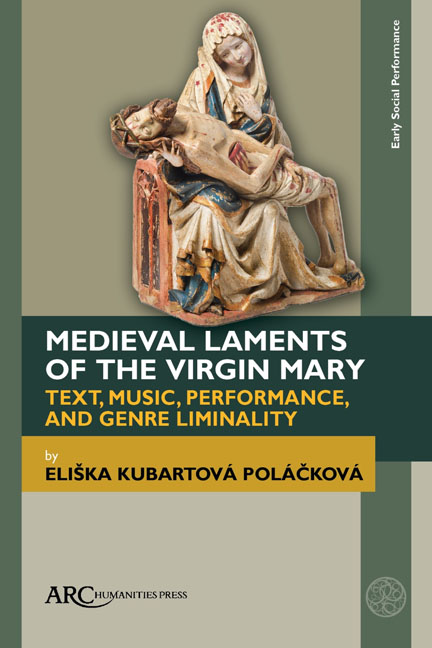Book contents
- Frontmatter
- Contents
- List of Illustrations
- Preface
- Introduction. The Suffering of the Virgin Mary as an Inner Drama
- Chapter One Marian Lament and Medieval Piety
- Chapter Two Genre, Mediality and Aesthetics
- Chapter Three Modes of Performance
- Chapter Four Bohemian Laments: Feeling Like a Woman, Thinking Like a Man. Or Not?
- Appendix: Bohemian Marian Laments — Excerpts
- Bibliography
- Index
Introduction. The Suffering of the Virgin Mary as an Inner Drama
Published online by Cambridge University Press: 28 December 2023
- Frontmatter
- Contents
- List of Illustrations
- Preface
- Introduction. The Suffering of the Virgin Mary as an Inner Drama
- Chapter One Marian Lament and Medieval Piety
- Chapter Two Genre, Mediality and Aesthetics
- Chapter Three Modes of Performance
- Chapter Four Bohemian Laments: Feeling Like a Woman, Thinking Like a Man. Or Not?
- Appendix: Bohemian Marian Laments — Excerpts
- Bibliography
- Index
Summary
THE FIGURE OF the Virgin Mary ranks among the most prominent figures of medieval Christian culture, and, for that matter, Christian culture in any historical period from the institution of the Church in the first centuries of the first millennium until the present. A woman who bore the Son of God, she can be counted among similar figures, divine and non-divine, in other religions, such as the Phrygian Cybele, Greek Rhea, Roman Magna Mater, or Indian Parvati. Through them, the appearance of the divine in the world is likened to the basic human experience of (giving) birth, elevating the concept of motherhood to a universal theological principal. While sharing some characteristics with these instances of maternal deity, the Christian Virgin also appears to differ substantially from them in several ways. Most importantly, the mother of the Christ is not conceived of as a deity but, on the contrary, her humanity is emphasized to underscore the paradoxical nature of the Christian god who decided to take on himself the human condition, to the extent of being born to the world in flesh and even of dying the most terrible death on the cross, in order to redeem the sins of humankind. As Theotokos or Deipara, the god-bearer, Mary, in Christian thinking, symbolizes and accentuates this ultimate proof of God's love for man. She also creates a powerful and meaningful link between theological discourse and the lived experience of ancient and medieval Christian believers. The abstract notions of the redemption of sin and the dogma of one god in three persons become concretized and more familiar in the image of the Virgin giving birth to the Son of God, and suffering together with him in the moment of his death. This introduces into Christian doctrine universal elements of the human condition such as affectionate relationships between parents and children, grieving over the death of loved ones, or being subject to an authoritative vocation. The Mother of God thus bridges the gap between the human and the divine, sharing, on one hand, Christ's divine status, as his coredemptrix, co-saviour, while she nonetheless remains palpably human in her motherhood of the divine child, which leaves her vulnerable and exposed to experiences very much like her earthly devotees.
- Type
- Chapter
- Information
- Medieval Laments of the Virgin MaryText, Music, Performance, and Genre Liminality, pp. 1 - 28Publisher: Amsterdam University PressPrint publication year: 2023



